When it comes to job searching or employment, emails are the most efficient form of communication in Japan.
Japanese use ‘’sonkeigo’’, which is an honorific way of speaking in which you elevate the rank of the person you're speaking to.
And you are probably wondering what this has to do with writing an Email in Japanese?!
Not everything in Japanese emails is about language.
It also has a lot to do with understanding Japanese culture.
In this article, we will explore 6 essential steps to implement when crafting these emails and offer a solution to help you create them effortlessly.
Let’s see how it is done in the land of the rising sun!
How to Write Emails in Japanese in 6 Steps
Here are 6 steps to remember while composing a Japanese email. We will also provide some examples to help you create them.
1. Start With the Right Email Format
When writing an email in Japanese, there is an appropriate format, which may differ slightly from your native English-speaking experience.
🎯 Proper Japanese email composition:
- Subject line
- Recipient
- Sender
- Body
- Concluding words
- Signature
General example:
%20(1)%20(1)%20(1)%20(1).png)
Let us explain how this composition works in practice step by step.
2. Create a Descriptive Subject Line
Japanese email subject lines are typically longer and more specific compared to English emails, containing a detailed description of the email's content.
This approach ensures that the recipient knows precisely what to expect from your email before opening it.
Here are some most common examples:
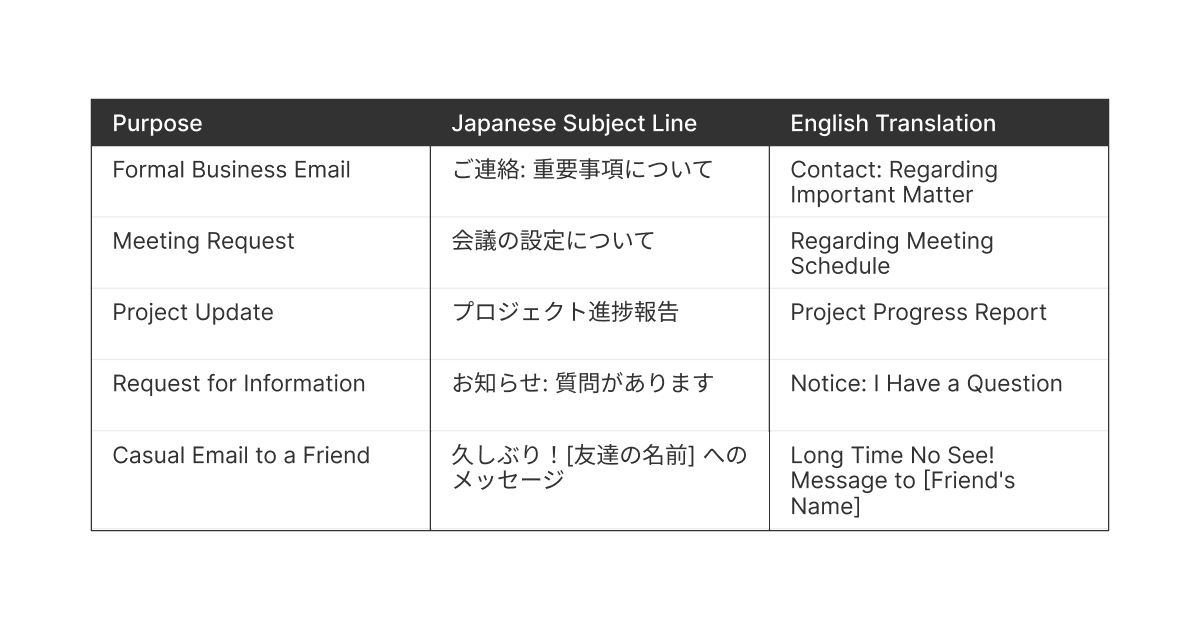
A poorly written email subject line significantly reduces the likelihood of the recipient opening the email, as it may not appear important or relevant.
Let's follow the next step and learn about the recipient.
2. Address Your Email to the Specific Recipient
Because of the Japanese honorific system we mentioned earlier, selecting the appropriate suffix depends on the level of formality and the recipient's status.
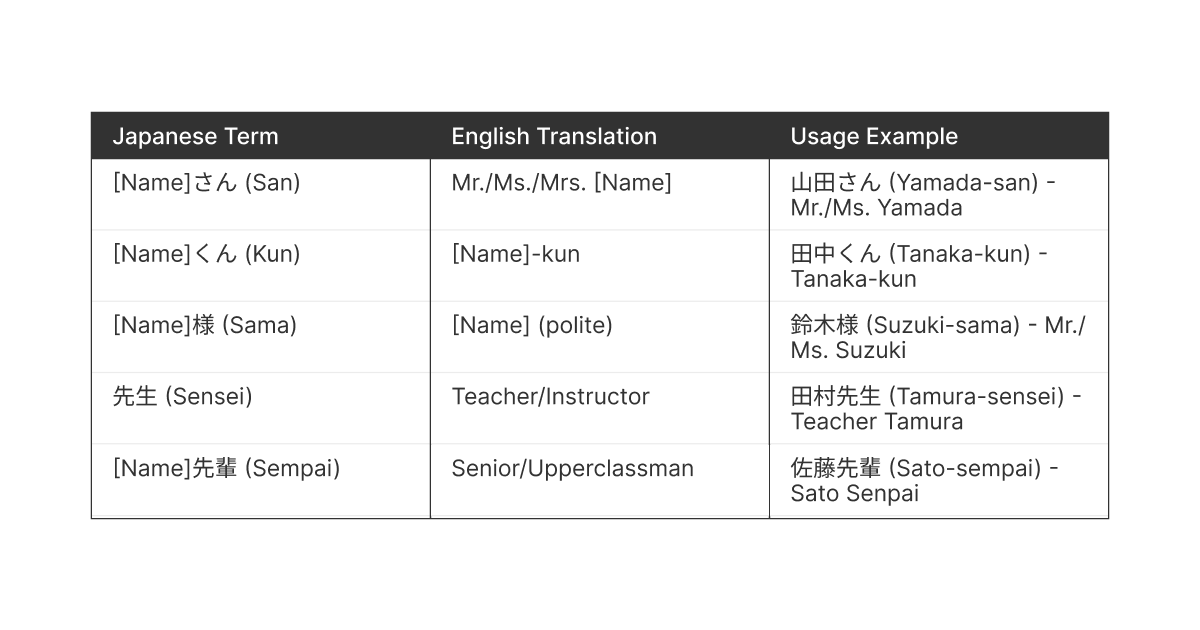
"Sama" and "san" are the most commonly used honorifics, typically employed to address individuals of higher rank or those deserving of respect.
However, It is not only important to write a name and proper suffix. But you should also include the company name and department.
Examples:
✒️[Department Name] 部 = (bu)
✒️人事部 (Jinji-bu) - Human Resources Department
✒️財務部 (Zaimu-bu) - Finance Department
✒️開発部 (Kaihatsu-bu) - Development Department
✒️営業部 (Eigyō-bu) - Sales Department
You can use the department name followed by "部"(bu) to address a specific department in your email.
This is a common and appropriate way to address a department in Japanese email communication.
Now, after we learned how to address the recipient, we should pay attention to the email sender.
3. Properly Populate the Email Sender Information
Remember that not every web browser or mobile phone will display your personal information and occupation details correctly when managing your email.
This is why you must write in detail who you are to the recipient.
A typical sender introduction pattern includes:
- Full name
- Name of your company
- Your current position/department
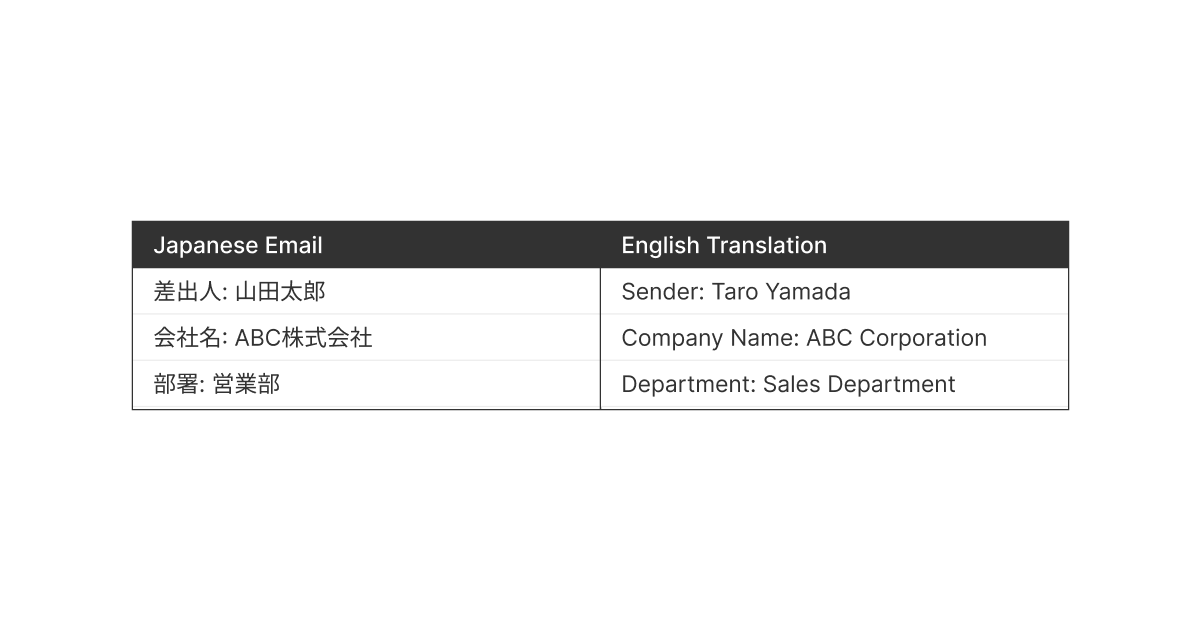
💡Remember that the pattern of required information in every Japanese email for both sender and recipient stays the same.
4. Keep Your Email Body Strong
The email body must explain your intentions and correlate with the subject line.
Your email is strong and, therefore, more interesting if it contains clear information.
Make sure to phrase it in a formal, courteous manner.
Here are top examples of how to present the body of your email in different situations:
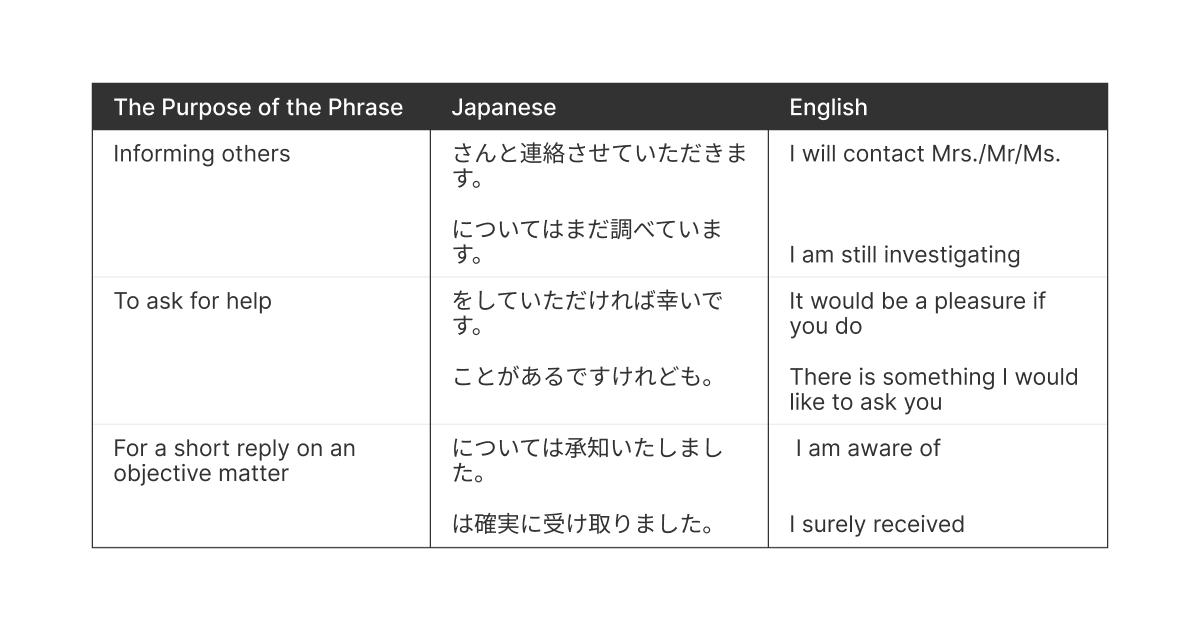
💡It is preferable to write “I am very sorry to trouble you but…” before approaching someone of a higher level to request assistance:
When contacting the company for the first time, we suggest you include an introduction that includes your industry of interest and the reason for your application.
Note: Don’t forget to make a note of any attachments within your email.
5. Finish with Polite Conclusion
Now is the right moment to use polite speech (Keigo) to finish your email.
Here are some short examples of how to close your email:
✒️どうぞよろしくお願いいたします。 (Douzo yoroshiku onegaishimasu)
Translation: Best regards / Kindly regards
✒️よろしければ、お知らせください。 (Yoroshikereba, oshirasukudasai)
Translation: Please let me know if you can / If you are willing, please inform me
✒️お世話になっております。(Osewa ni natte orimasu)
Translation: Thank you for your continued support.
These short and simple phrases can be used to conclude your emails in Japanese, depending on the level of formality and your relationship with the recipient.
6. Include Your Signature Before You Send It
To finalize your email in Japanese, you should sign it by writing down this information:
- The company you work for
- Your company position
- Full name and address you are available at
- Personal Phone number
- Your full email address
Example:
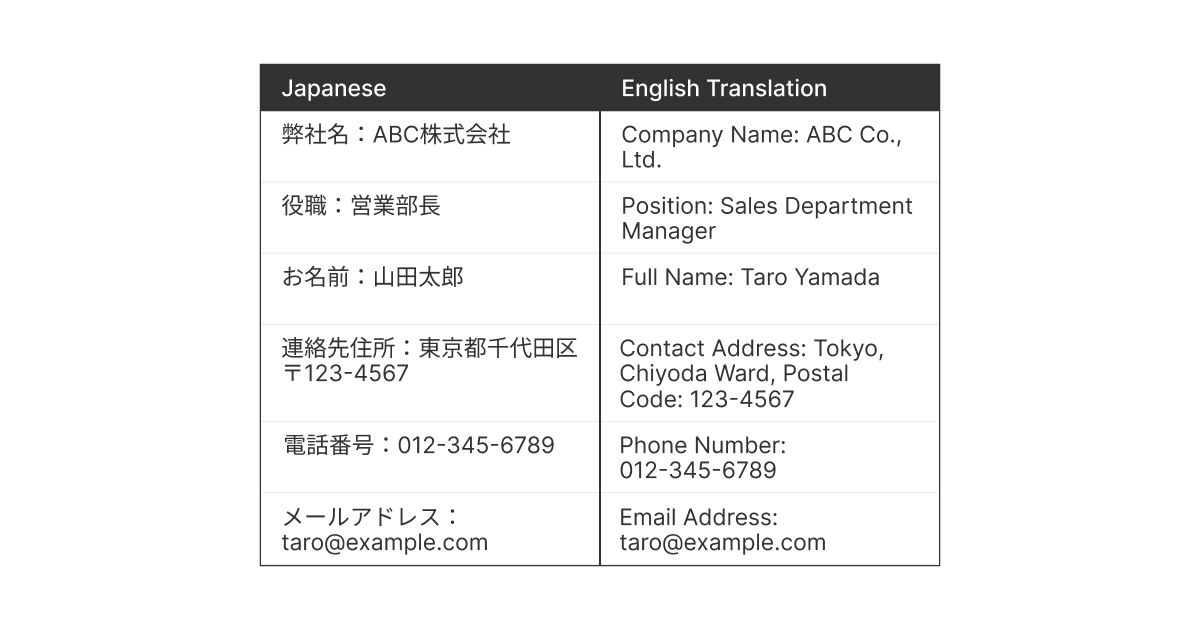
What To Keep in Mind When Writing Japanese Emails?
In addition to the steps we've provided, there are some do's and don'ts to consider when crafting these emails. We'll emphasize a few that are extremely important.
DO’S
✔️ Be punctual and respond promptly to emails to demonstrate professionalism.
✔️ Use formal language and honorific terms when in doubt to maintain respect.
✔️ Engage in small talk to show thoughtfulness and kindness in your communication.
✔️ Consider the recipient's position and adjust your tone accordingly to allow you a more casual approach with friends or coworkers.
DON’TS
🚫 Don't forget to elevate your level of formality when emailing seniors, strangers, or those you're requesting.
🚫 Avoid overusing honorifics, as it can come across as forced.
🚫 Ignore phrases like "Dear" and "Sincerely," as they are more suitable for letters rather than emails.
🚫 Exercise caution when selecting Cc or Bcc, as Japanese companies often adhere to the Personal Data Protection Law.
🚫 Stick to one email per topic to ensure clarity and organization in your communication.
Conclusion
In conclusion, mastering the art of writing emails in Japanese requires attention to cultural nuances, formality, and respect.
Following the steps and guidelines from this guide will make it much easier for you to navigate the intricacies of Japanese email etiquette confidently.
Whether you're communicating with colleagues, clients, or friends, writing high-quality emails in Japanese is essential.
That’s where various AI translation software can help you drastically.
Let us introduce you TextCortex.
TextCortex is a powerful AI writing and task automation tool that can help you:
🎖️Automate writing tasks using 100+ AI templates.
🎖️Translate any type of text into 25+ different languages (including Japanese).
🎖️Rewrite sentences and paragraphs effortlessly.
🎖️Summarize content to make it shorter and easier to read.
🎖️Expand ideas into detailed texts.
🎖️Write sentences using different tones of voice.
🎖️Integrate with different platforms like Notion, Canva, Zendesk, Slack, Zapier, etc.
On top of that, TextCortex’s conversational AI assistant, called ZenoChat, can help you create any form of content just by providing it with prompts based on your needs.
Here’s how it works:
Why use TextCortex?
Besides the numerous benefits that TextCortex provides, here are the ones to consider trying it:
🎀 Provides you with a freemium account.
🎀 No need for credit card details.
🎀 Allows you to test its functionality and features using 20 free creations per day.
🎀 Provides you with flexible pricing plans if you decide to use its full potential.
Sounds interesting?
Sign up and get your free account today to start writing compelling Emails in Japanese in seconds.


.webp)

